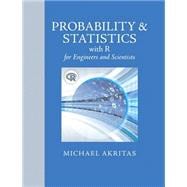This text grew out of the author’s notes for a course that he has taught for many years to a diverse group of undergraduates. The early introduction to the major concepts engages students immediately, which helps them see the big picture, and sets an appropriate tone for the course. In subsequent chapters, these topics are revisited, developed, and formalized, but the early introduction helps students build a true understanding of the concepts. The text utilizes the statistical software R, which is both widely used and freely available (thanks to the Free Software Foundation). However, in contrast with other books for the intended audience, this book by Akritas emphasizes not only the interpretation of software output, but also the generation of this output. Applications are diverse and relevant, and come from a variety of fields.








